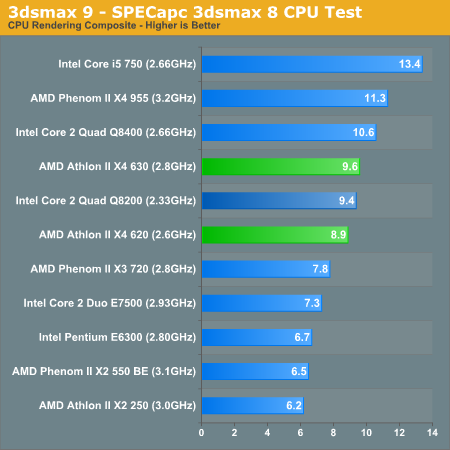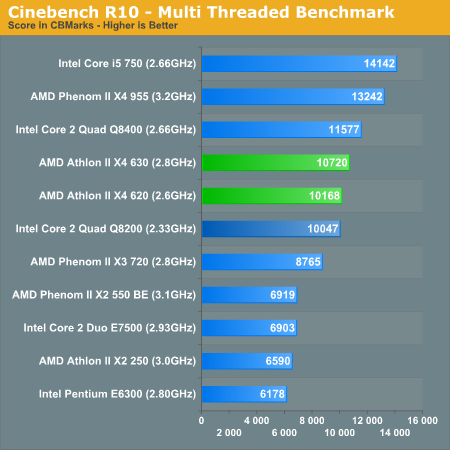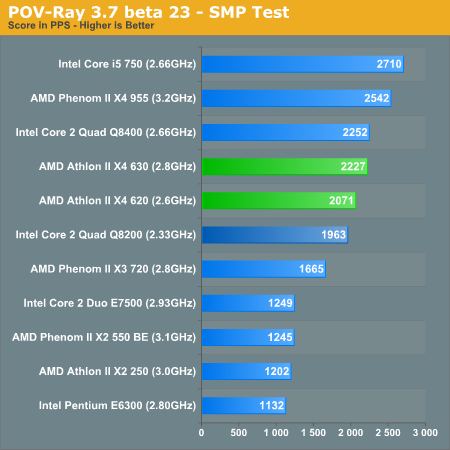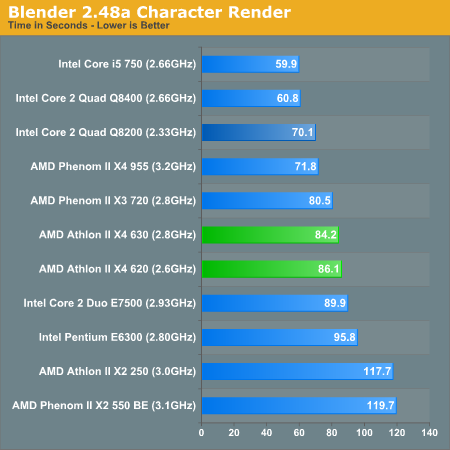AMD Athlon II X4 620 & 630: The First $99 Quad Core CPU
by Anand Lal Shimpi on September 16, 2009 12:00 AM EST- Posted in
- CPUs
3dsmax 9 - SPECapc 3dsmax CPU Rendering Test
Today's desktop processors are more than fast enough to do professional level 3D rendering at home. To look at performance under 3dsmax we ran the SPECapc 3dsmax 8 benchmark (only the CPU rendering tests) under 3dsmax 9 SP1. The results reported are the rendering composite scores:

Offline 3D rendering should be another safe haven for the Athlon II X4. Core count matters and that's what AMD delivers. At $25 per core the Athlon II X4 620 is faster than even the X3 720. It's of course faster than any dual-core CPU in its price range, including the more expensive E7500. Intel's Core 2 Quad Q8200 is around 6% faster but costs 60% more.
Cinebench R10
Created by the Cinema 4D folks we have Cinebench, a popular 3D rendering benchmark that gives us both single and multi-threaded 3D rendering results.

Single threaded performance is where the Athlon II X4 suffers the most. It's competitive but still slower than cheaper dual-core CPUs. This is the classic trade off for all pre-Lynnfield quad-core CPUs, you give up single threaded performance for multi-threaded performance. Luckily for AMD, Intel's Core 2 Quads suffer the same fate. While the Athlon IIs find themselves at the bottom of this chart, the Q8200 is the slowest chip here.

Turn up the thread count and the Athlon II shines once more. Again, the 620 is about the same speed as the Q8200, but slower than the Q8400. Just where it needs to be.
POV-Ray 3.73 beta 23 Ray Tracing Performance
POV-Ray is a popular, open-source raytracing application that also doubles as a great tool to measure CPU floating point performance.
I ran the SMP benchmark in beta 23 of POV-Ray 3.73. The numbers reported are the final score in pixels per second.

At this point I couldn't write a more competitive position for AMD. The Athlon II X4 continues to do very well in our 3D rendering tests.
Blender 2.48a
Blender is an open source 3D modeling application. Our benchmark here simply times how long it takes to render a character that comes with the application.

Our Blender test has traditionally favored Intel architectures, and here we see the first signs of the Athlon II X4 not being able to keep up. The Phenom II X3 720 and Core 2 Quad Q8200 are both faster, but compared to Intel's similarly priced dual-core offerings AMD is still quicker.










150 Comments
View All Comments
fitten - Wednesday, September 16, 2009 - link
Your definition of "overclocked" is flawed. Back under the bridge with you!philosofa - Wednesday, September 16, 2009 - link
Can someone please ban this moron, and the others (who ironically I assume are on AMD's payroll?). Their lack of an understanding of the most basic logic is making me feel ill.Good Review though, just really want Bulldozer to come out!
james jwb - Thursday, September 17, 2009 - link
why can't people like you understand what is meant? I can handle my own CPU, so for me, i want to know which one is better clock for clock, and then see what the average each overclock to, then i'll jump in and buy one.The way data is currently being presented here isn't right, we need both ways (stock results with turbo on, and clock for clock style stuff for us overclockers).
Get it now? Probably not.
bupkus - Wednesday, September 16, 2009 - link
"Their lack of an understanding of the most basic logic is making me feel ill."Take a Tums; we're not interested.
rennya - Wednesday, September 16, 2009 - link
Overclocking is not the same as turbo mode.Overclocking voids your warranty, whether you use Intel or AMD CPUs.
Turbo mode doesn't void warranty because it is a valid feature.
SlyNine - Wednesday, September 16, 2009 - link
lol You will make your own little universe in your mind. okay lol.Overclocking. Lets see. Over, meaning above normal. Well since the post turbo mode clock is perfectly normal. Its not OVER clocking.
vol7ron - Wednesday, September 16, 2009 - link
Just because the clock rate is variable, does not mean it's [over/under]clocking. It just means the speeds change. In fact, even when you are running at stock speeds, the clock rate will vary - that is why you see 3.541 3.500 3.489To complain it's not a fair comparison, he's kind of right, but not for the right reason. It's as if he's in AMDs defense, rather than their scrutiny. Instead of comparing peaches-to-peaches, now you're comparing nectarines-to-peaches and there's two ways to look as this glass: Intel is turbo-ing during fewer threads, or Intel is decelerating in multithreaded situations; both have the same effect. (They're either trying to give you more bang for the buck, or they put out a bad product that only works half the time)
The end result, though, AMD doesn't do this on the fly. Sure you could test it at different clock speeds, but you could also overclock the i7 to something faster (and you might be back at square one).
Chlorus - Wednesday, September 16, 2009 - link
"remember that the lynnfield core i7 750 has turbo overclocking enabled so is overclocked to 3.2 ghz, which is 600 mhz overclocking, while amd processors are running at stock speedIs unfair to present the results this way, turbo is overclocking. "
Its not overclocking if ITS ON BY DEFAULT, you worthless troll.
hanhan1982923 - Wednesday, April 14, 2010 - link
22222222222222Thomas369 - Saturday, July 28, 2018 - link
The Athlon architecture also used the EV6 bus licensed from DEC as its main system bus. Intel required licensing to use the GTL+ bus used by its Slot 1 Pentium II and later processors. By licensing the EV6 bus used by the Alpha line of processors from DEC, AMD was able to develop its own chipsets and motherboards, and avoid being dependent on licensing from its direct competitor. https://chasebanklogin.us/chase-credit-card-login/